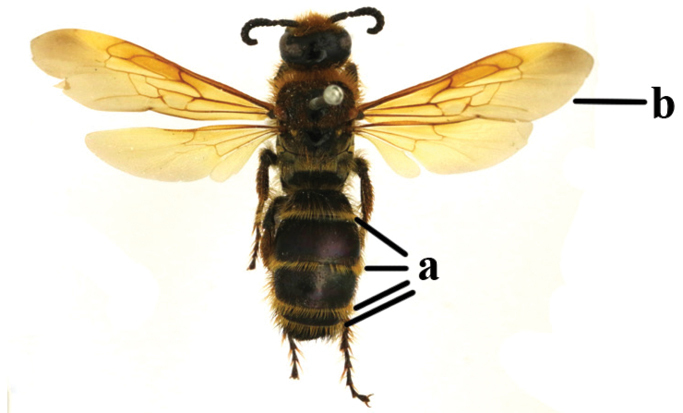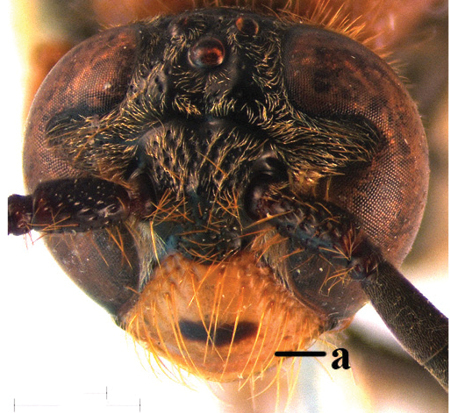| 1 | Female, antenna with 12 segments (female of M. szetschwanensis (Betrem, 1928) unknown) | 2 |
| – | Male, antenna with 13 segments (males of M. bella (Bingham, 1897), M. grossa (Fabricius, 1804) and M. stoetzneri (Betrem, 1928) unknown) | 14 |
| 2 | Fringes of T1–T3 white or whitish (a) | 3 |
| – | Fringes of T1–T3 yellow, reddish-yellow or black (aa) | 8 |

| ||
| 3 | At least T1 more or less yellow or pale yellow posteriorly (a) | 4 |
| – | Metasomal tergites completely black (aa) | 6 |

| ||
| 4 | Vertex, behind ocelli, largely smooth (a); frons, in front of ocelli, narrowly smooth (b); mesoscutum smooth medially (c) | M. schulthessi (Betrem, 1928) |

| ||
| – | Vertex (aa) and frons (bb) largely, densely and deeply punctate; mesoscutum entirely densely punctate (cc) | 5 |

| ||
| 5 | Spiracular corner (a) and vertical portion of upper plate of metapleuron (b) impunctate; upper plate of metapleuron divided by a well-defined ridge into a punctate dorsal portion and an impunctate vertical portion (c) | M. bella (Bingham, 1897) |
| – | Spiracular corner punctate (aa); vertical portion of upper plate of metapleuron punctate just below transition from dorsal portion and with few punctures along anterior and posterior sutures (bb); transition from dorsal to vertical portion of upper plate of metapleuron gradual, not carina-like (cc) | M. stoetzneri (Betrem, 1928) |

| ||
| 6 | Vertex entirely smooth behind ocelli (a); setae blackish above antennal insertion and along inner margin of eyes (b) | M. grossiformis Betrem, 1928 |
| – | Vertex densely punctate behind ocelli (aa); head setae yellow or yellowish-brown (bb) | 7 |

| ||
| 7 | Mesoscutum and scutellum smooth, except for few punctures laterally (a); metanotum broadly smooth medially (b) | M. farrenwhitei Betrem, 1928 |
| – | Mesoscutum and scutellum nearly entirely densely punctate, except for more or less smooth area posteromedially (aa); metanotum densely punctate (bb) | M. grossa (Fabricius, 1804) |

| ||
| 8 | Fringes of T1–T4 blackish-brown to black; wings distinctly darkened | M. binghami (Betrem, 1928) |
| – | Fringes of T1–T4 brown or yellowish-brown (a); wings subhyaline and yellowish (b) | 9 |

| ||
| 9 | T1 and T2, sometimes including T3, with a yellow or pale yellow band posteriorly (a) | 10 |
| – | Tergites entirely black (aa) | 11 |

| ||
| 10 | Bands on tergites distinct, T3 usually with yellow area posteriorly (a); scutellum largely smooth medially (b); basal elevation of T2 (“gradulus”) distinctly developed (c) | M. formosensis Betrem, 1928 |
| – | Bands on tergites indistinct, T3 without yellow area (aa); scutellum evenly and densely punctate (bb); basal elevation of T2 absent (cc) | M. limbata (de Saussure & Sichel, 1864) |

| ||
| 11 | Vertex smooth latero-posteriorly (a) | M. lindenii (Lepeletier, 1845) |
| – | Vertex coarsely punctate latero-posteriorly (aa) | 12 |

| ||
| 12 | Scutellum largely smooth (a); wings without infuscation subapically (b); median groove of frons distinct (c) | M. farrenwhitei Betrem, 1928 |

| ||
| – | Scutellum punctate anteriorly (aa), if largely smooth, then wings with subapical infuscation (bb); median groove of frons partly or almost completely missing (cc) | 13 |

| ||
| 13 | Fringes of T1–T4 yellowish-brown and black on other tergites (a); antenna black (b); scutellum entirely or only anteriorly punctate (c) | M. prismatica (Smith, 1855) |

| ||
| – | Tergites setae yellowish-brown; antenna reddish-yellow; scutellum largely smooth | M. ceylonica (Kirby, 1889) |
| 14 | Tergites setae red or reddish-brown (a); legs yellowish-brown (b) | M. ceylonica (Kirby, 1889) |
| – | Setae pale yellowish (aa) or reddish-brown and, on T6–T7, black (aaa); legs mainly black (bb) | 15 |

| ||
| 15 | Clypeus mostly black, at most with two small lateral yellowish areas above mandible base | 16 |
| – | Clypeus at least broadly yellow laterally (a) | 19 |

| ||
| 16 | Wings more or less darkened (a) | M. binghami (Betrem, 1928) |
| – | Wings subhyaline (aa) | 17 |

| ||
| 17 | Posterodorsal margin of pronotum pale yellow; scutellum without medio-longitudinal carina | M. schulthessi (Betrem, 1928) |
| – | Posterodorsal margin of pronotum only indistinctly narrowly yellow posteriorly (a); scutellum and metanotum with a more or less distinct medio-longitudinal carina (b) | 18 |

| ||
| 18 | Setae on mesosoma yellowish and sparse (a); punctures sparse, intervals 1–2× larger than puncture diameter (b) | M. formosensis (Betrem, 1928) |
| – | Setae on mesosoma reddish and dense (aa); punctures dense, intervals often smaller than puncture diameter (bb) | M. szetschwanensis (Betrem, 1928) |

| ||
| 19 | Clypeus always black medio-ventrally and remainder more or less yellow (a) | 20 |
| – | Clypeus always yellow medially (aa) | 22 |

| ||
| 20 | Yellow bands on T1 wide, covering nearly 1/3 of T1; scutellum always with two lateral yellow spots | M. limbata (de Saussure & Sichel, 1864) |
| – | Yellow bands on T1 narrow, at most covering 1/5 of T1; scutellum often entirely black, rarely with yellow spots | 21 |
| 21 | Hind femur yellow ventrally (a); S2–S4 often with yellow cuneate maculae lateroapically (b) | M. farrenwhitei Betrem, 1928 |
| – | Hind femur black ventrally (aa); S2–S4 rarely with yellow maculae (bb) | M. prismatica (Smith, 1855) |

| ||
| 22 | T5 usually with yellow band posteriorly; setae of mesosoma dirty white; pronotum black | M. grossiformis Betrem, 1928 |
| – | T5 without a yellow band (a); setae of mesosoma reddish or yellowish-brown (b); pronotum entirely or mostly reddish-yellow (c) | M. lindenii (Lepeletier, 1845) |

| ||

An official website of the United States government
Here's how you know
Official websites use .gov
A
.gov website belongs to an official
government organization in the United States.
Secure .gov websites use HTTPS
A lock (
) or https:// means you've safely
connected to the .gov website. Share sensitive
information only on official, secure websites.